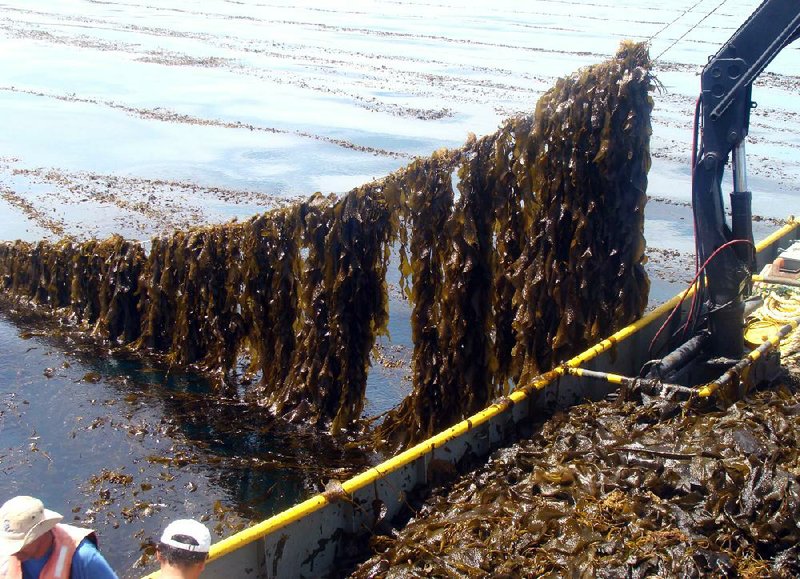WASHINGTON — Farming for seaweed as a fuel feedstock has the potential to emerge as an option as the world looks for ways to reduce the use of fossil fuels, scientists say. The technology already is in the earliest stages of testing in Chile.
Last week, a breakthrough in the development of biofuels and useful chemicals from seaweed made the cover of the current issue of Science magazine. The article tells how scientists from Bio Architecture Lab in Berkeley, Calif., engineered a microbe that can convert the sugars in brown, inedible seaweed into energy.
Efforts to develop biofuels from land plants other than corn and sugar have run into the difficulty of finding an economical way to break down the part of the plant that gives it structure - lignin - and use its sugars to make fuel.
Seaweed doesn’t have any lignin, but it has another substance that locks up sugars - alginate. Bio Architecture Lab’s breakthrough was engineering a microbe to extract sugars from alginate and convert them into fuels and chemicals.
“In the oil industry, oil wells are black wells in the ocean. We spend billions of dollars on refineries to convert that feedstock into usable fuel or chemicals,” said Daniel Trunfio, the company’s chief executive officer and a retired Royal Dutch Shell executive.
“There’s really no difference. Our wells are in the ocean also, but they’re green and renewable,” Trunfio said.
Like other biofuels, however, seaweed would need space. The company estimates that 3 percent of the world’s coasts where kelp grows could be used to make enough ethanol to replace 60 billion gallons of fossil fuel. That’s about 4 percent of global transportation fuel demand.
Seaweed farms also would compete with other uses of the coasts, such as conservation, aquaculture, fishing, recreation and possibly other future forms of renewable energy such as offshore wind, and tidal and wave energy.
Trunfio said seaweed ethanol would have lower greenhouse gas emissions than gasoline. His company has a partnership with Statoil, the Norwegian oil and gas company, to make ethanol. It’s also working with DuPont, which received a grant from the Department of Energy’s Advanced Research Projects Agency-Energy - or ARPA-E - to use seaweed to make isobutanol, an advanced biofuel.
ARPA-E’s fact sheet for the project says that isobutanol could be blended in gasoline at higher levels than ethanol without changes to vehicles.
It’s also projected to reduce greenhouse-gas emissions by more than 90 percent compared with gasoline from petroleum.
Trunfio said that while his company’s advance “has game-changing potential,” it still has many more steps ahead, including building a pilot plant in Chile, figuring out what products to make and commercializing them.
Jonathan Burbaum, the ARPA-E program director for biofuels and biologically produced chemical feedstocks, said the Bio Architecture Lab venture with DuPont has “proceeded apace,” but “there’s a milestone we’re still waiting on.” He said he couldn’t give details because the information was proprietary.
“I think it’s definitely worth looking at,” he said. “There’s nothing at this point that’s a showstopper. We’ve got a situation where it would require the development of an offshore aquaculture industry for there to be enough feedstock to really compete with things like corn and cellulose. But it’s the sort of thing, where if it’s successful, it will be a game changer, so that fits what ARPA-E looks for.”
The company says seaweed’s advantages as a feedstock make it attractive: It needs no fertilizer, land or fresh water, and it can be used to make 1,200 to 1,500 gallons of ethanol per acre, compared with 450 gallons per acre of corn and 900 to 1,000 gallons per acre of sugar cane.
Matt Hartwig, chief of staff of the Renewable Fuels Association, the U.S. ethanol trade group, said last week that he hadn’t heard of the Bio Architecture Lab’s seaweed breakthrough, but he wasn’t surprised.
“It’s no more far-fetched than the notion of using algae or any other material,” he said. “The biofuels industry is in a constant state of innovation.”
Business, Pages 21 on 01/23/2012
